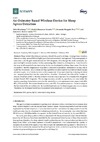Identificador persistente para citar o vincular este elemento:
https://accedacris.ulpgc.es/handle/10553/70470
| Campo DC | Valor | idioma |
|---|---|---|
| dc.contributor.author | Mendonça, Fábio | en_US |
| dc.contributor.author | Mostafa, Sheikh Shanawaz | en_US |
| dc.contributor.author | Morgado-Dias, Fernando | en_US |
| dc.contributor.author | Ravelo García, Antonio Gabriel | en_US |
| dc.date.accessioned | 2020-02-22T06:03:49Z | - |
| dc.date.available | 2020-02-22T06:03:49Z | - |
| dc.date.issued | 2020 | en_US |
| dc.identifier.issn | 1424-8220 | en_US |
| dc.identifier.other | Scopus | - |
| dc.identifier.uri | https://accedacris.ulpgc.es/handle/10553/70470 | - |
| dc.description.abstract | Sleep related disorders can severely disturb the quality of sleep. Among these disorders, obstructive sleep apnea (OSA) is highly prevalent and commonly undiagnosed. Polysomnography is considered to be the gold standard exam for OSA diagnosis. Even though this multi-parametric test provides highly accurate results, it is time consuming, labor-intensive, and expensive. A non-invasive and easy to self-assemble home monitoring device was developed to address these issues. The device can perform the OSA diagnosis at the patient’s home and a specialized technician is not required to supervise the process. An automatic scoring algorithm was developed to examine the blood oxygen saturation signal for a minute-by-minute OSA assessment. It was performed by analyzing statistical and frequency-based features that were fed to a classifier. Afterward, the ratio of the number of minutes classified as OSA to the time in bed in minutes was compared with a threshold for the global (subject-based) OSA diagnosis. The average accuracy, sensitivity, specificity, and area under the receiver operating characteristic curve for the minute-by-minute assessment were, respectively, 88%, 80%, 91%, and 0.86. The subject-based accuracy was 95%. The performance is in the same range as the best state of the art methods for the models based only on the blood oxygen saturation analysis. Therefore, the developed model has the potential to be employed in clinical analysis. | en_US |
| dc.language | eng | en_US |
| dc.relation.ispartof | Sensors | en_US |
| dc.source | Sensors (Switzerland) [ISSN 1424-8220], v. 20 (3) | en_US |
| dc.subject | 3314 Tecnología médica | en_US |
| dc.subject.other | Apnea | en_US |
| dc.subject.other | Home Monitoring Device | en_US |
| dc.subject.other | Osa | en_US |
| dc.subject.other | Spo2 | en_US |
| dc.title | An oximetry based wireless device for sleep apnea detection | en_US |
| dc.type | info:eu-repo/semantics/Article | en_US |
| dc.type | Article | en_US |
| dc.identifier.doi | 10.3390/s20030888 | en_US |
| dc.identifier.scopus | 85079338328 | - |
| dc.contributor.authorscopusid | 57195946416 | - |
| dc.contributor.authorscopusid | 55489640900 | - |
| dc.contributor.authorscopusid | 57200602527 | - |
| dc.contributor.authorscopusid | 9634135600 | - |
| dc.identifier.issue | 3 | - |
| dc.relation.volume | 20 | en_US |
| dc.investigacion | Ciencias de la Salud | en_US |
| dc.type2 | Artículo | en_US |
| dc.utils.revision | Sí | en_US |
| dc.identifier.ulpgc | Sí | en_US |
| dc.description.sjr | 0,636 | |
| dc.description.jcr | 3,576 | |
| dc.description.sjrq | Q2 | |
| dc.description.jcrq | Q2 | |
| dc.description.scie | SCIE | |
| item.grantfulltext | open | - |
| item.fulltext | Con texto completo | - |
| crisitem.author.dept | GIR IDeTIC: División de Procesado Digital de Señales | - |
| crisitem.author.dept | IU para el Desarrollo Tecnológico y la Innovación | - |
| crisitem.author.dept | Departamento de Señales y Comunicaciones | - |
| crisitem.author.orcid | 0000-0002-8512-965X | - |
| crisitem.author.parentorg | IU para el Desarrollo Tecnológico y la Innovación | - |
| crisitem.author.fullName | Ravelo García, Antonio Gabriel | - |
| Colección: | Artículos | |
Citas SCOPUSTM
25
actualizado el 25-may-2025
Citas de WEB OF SCIENCETM
Citations
20
actualizado el 25-may-2025
Visitas
71
actualizado el 16-dic-2023
Descargas
54
actualizado el 16-dic-2023
Google ScholarTM
Verifica
Altmetric
Comparte
Exporta metadatos
Los elementos en ULPGC accedaCRIS están protegidos por derechos de autor con todos los derechos reservados, a menos que se indique lo contrario.
